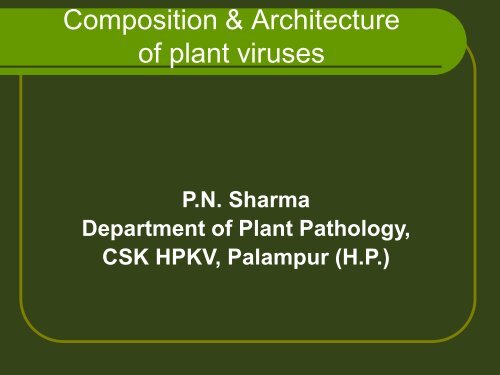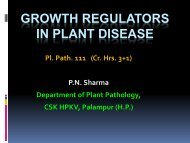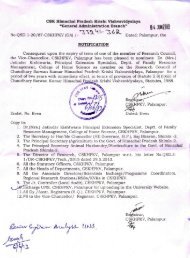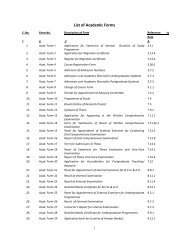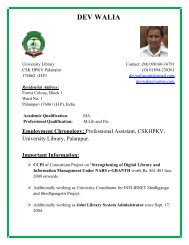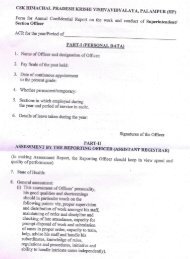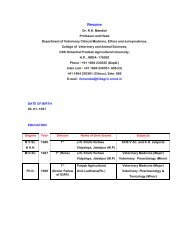Lect. 6 composition & Architecture of plant viruses
Lect. 6 composition & Architecture of plant viruses
Lect. 6 composition & Architecture of plant viruses
Create successful ePaper yourself
Turn your PDF publications into a flip-book with our unique Google optimized e-Paper software.
Composition & <strong>Architecture</strong><br />
<strong>of</strong> <strong>plant</strong> <strong>viruses</strong><br />
P.N. Sharma<br />
Department <strong>of</strong> Plant Pathology,<br />
CSK HPKV, Palampur (H.P.)
Plant Viruses<br />
Classification, Morphology, Genome,<br />
and Structure
Importance<br />
• Detailed knowledge <strong>of</strong> virus structure is<br />
important to understand different aspects <strong>of</strong><br />
virology e.g. how virus survive, infect, spread,<br />
replicate and how they are related with one<br />
other.<br />
• Knowledge <strong>of</strong> virus architecture has increased<br />
greatly with the invention <strong>of</strong> EM, optical<br />
defraction, X-ray crystallography procedures;<br />
• Molecular techniques<br />
• Chemical information about <strong>viruses</strong>
Morphology <strong>of</strong> Viruses<br />
• About ½ <strong>of</strong> all known <strong>plant</strong> <strong>viruses</strong> are<br />
elongate (flexuous threads or rigid rods).<br />
• About ½ <strong>of</strong> all known <strong>plant</strong> <strong>viruses</strong> are<br />
spherical (isometric or polyhedral).<br />
• A few <strong>viruses</strong> are cylindrical bacillus-like<br />
rods.
Chemical <strong>composition</strong> <strong>of</strong> <strong>plant</strong> <strong>viruses</strong><br />
• Protein( Capsid)<br />
• Capsomere<br />
• Nucleic acids<br />
• RNA<br />
• +ve strand RNA<br />
• -ve strand RNA<br />
• ssRNA<br />
• dsRNA<br />
• DNA<br />
• ssDNA<br />
• dsDNA
Viral Composition<br />
• Proteins<br />
• 60-95% <strong>of</strong> the virion<br />
• Repeating subunits, identical for each virus type but<br />
varies from virus to virus and even from strain to<br />
strain<br />
• TMV subunits - 158 amino acids with a mass <strong>of</strong> 17,600<br />
Daltons (17.6 kDa, kd or K)<br />
• TYMV – 20,600 Dalton protein<br />
• Nucleic acid is 5-40% <strong>of</strong> the virion<br />
• Spherical <strong>viruses</strong>: 20-40%<br />
• Helical <strong>viruses</strong>: 5-6%
Viral Composition<br />
• Nucleic acid (5-40%) represents the genetic<br />
material, indispensable for replication<br />
• Nucleic acid alone is sufficient for virus<br />
replication – Fraenkel-Conrat, Schramm<br />
• Protein (60-95%) protects virus genome<br />
from<br />
• degradation<br />
• facilitates movement through the host and<br />
• transmission from one host to another
A/a <strong>composition</strong> <strong>of</strong> capsid proteins <strong>of</strong> some <strong>viruses</strong><br />
1. Alanine<br />
CMV: 17; PVY: 16<br />
TMV: 14; PVX: 76<br />
2. Arginine<br />
CMV: 24; PVY: 11<br />
TMV: 11; PVX: 18<br />
3. Asparatic acid<br />
CMV: 30; PVY: 22<br />
TMV: 18; PVX: 42<br />
6. Glutamine<br />
CMV: 20; PVY: 23<br />
TMV: 16; PVX: 33<br />
11. Leucine<br />
CMV: 26; PVY: 10<br />
TMV: 12; PVX: 19<br />
7. Glutamic acid 12. Lysine<br />
CMV: 18; PVY: 13<br />
TMV: 2; PVX: 22<br />
8. Glycine<br />
CMV: 16; PVY: 13<br />
TMV: 6 ; PVX: 23<br />
4. Asparagines 9. histidine<br />
CMV: 4; PVY: 4<br />
TMV: - ; PVX: 4<br />
5. Cystein<br />
CMV: 0; PVY: 1<br />
TMV: 1; PVX: 5<br />
10. Isoleucine<br />
CMV: 16; PVY: 12<br />
TMV: 9 ; PVX: 21<br />
13. Methionine<br />
CMV: 8; PVY: 8<br />
TMV: 0 ; PVX: 15<br />
14. Phenylalanine<br />
CMV: 7 ; PVY: 5<br />
TMV: 8; PVX: 22<br />
15. Proline<br />
CMV: 18; PVY: 11<br />
TMV: 8 ; PVX: 34<br />
16. Serine<br />
CMV: 32; PVY: 10<br />
TMV: 16; PVX: 31<br />
17. Tryptophane<br />
CMV: 1 ; PVY: 2<br />
TMV: 3; PVX: 9<br />
18. Tyrosine<br />
CMV: 11; PVY: 6<br />
TMV: 4; PVX: 4<br />
19. Threonine<br />
CMV: 17; PVY: 13<br />
TMV: 16; PVX: 58<br />
20. Valine<br />
CMV: 22; PVY: 13<br />
TMV: 14; PVX: 27<br />
Total CMV: 287 PVY: 203 TMV: 158 PVX: 463
%age <strong>of</strong> protein & n/a in some <strong>viruses</strong><br />
%age <strong>of</strong> protein & n/a in some <strong>viruses</strong><br />
Virus n/a (%) Protein (%)<br />
TMV 5 95<br />
PVX 6 94<br />
PVY 5 95<br />
CpMV 31-33 67-69<br />
CMV 18 82<br />
TRSV 40 60
Viral Ultrastructure<br />
• Terminology for virus components<br />
• Capsid is the protein shell that encloses the<br />
nucleic acid<br />
• Capsomers are the morphological units seen<br />
on the surface <strong>of</strong> particles and represent<br />
clusters <strong>of</strong> structure units<br />
• Capsid and enclosed nucleic acid is called the<br />
nucleocapsid<br />
• The virion is the complete infectious virus<br />
particle<br />
Caspar, D. L. D. and Klug, A. (1963) "Structure and Assembly <strong>of</strong> Regular Virus Particles." In<br />
Viruses, Nucleic Acids, and Cancer, 17th Annual Symposium on Fundamental Cancer<br />
Research, University <strong>of</strong> Texas, Williams and Wilkins, Baltimore, pp. 27-39.
Watson and Crick<br />
• In 1956 proposed:<br />
• Amount <strong>of</strong> the virus nucleic acid was<br />
insufficient to code for more than a few<br />
proteins <strong>of</strong> limited size<br />
• Therefore the protein shell must be <strong>of</strong> identical<br />
subunits<br />
• Subunits had to be arranged to provide<br />
each with an identical environment, i.e.,<br />
symmetrical packing
Virus <strong>Architecture</strong><br />
• Detailed knowledge <strong>of</strong> virus structure is<br />
important to understand different aspects<br />
<strong>of</strong> virology<br />
• Knowledge <strong>of</strong> virus architecture has<br />
increased greatly with the innovation like<br />
EM, optical defraction, X-Ray<br />
crystallography procedures, mol.<br />
techniques and chemical nature <strong>of</strong> the<br />
virus.
Various feature <strong>of</strong> <strong>viruses</strong> can be<br />
estimated by studying:<br />
• Chemical & biochemical studies<br />
• Size <strong>of</strong> particles<br />
• Hydrodynamics<br />
• Laser scattering has been used to determine the<br />
radii <strong>of</strong> spherical <strong>viruses</strong><br />
• E.M.<br />
• X-ray crystallography<br />
• it gives accurate estimates <strong>of</strong> radius <strong>of</strong> icosahedral<br />
<strong>viruses</strong> but condition is that the virus should be able to<br />
form stable crystals.
Electron microscopy<br />
• In 1924 L. de BROGLIE discovered the wave-character<br />
<strong>of</strong> electron rays thus giving the prerequisite for the<br />
construction <strong>of</strong> the electron microscope.<br />
• Invented by M. KNOLL and E. RUSKA (Technische<br />
Universität Berlin, 1932).<br />
• One <strong>of</strong> the first biological objects observed was the<br />
tobacco mosaic virus (TMV).<br />
• The first picture <strong>of</strong> a cell was published in 1945 by K. R.<br />
PORTER, A. CLAUDE and E. F. FULLAM (Rockefeller<br />
Institute, New York).<br />
• The Transmission Electron Microscope (TEM)<br />
• The Scanning electron microscope (SEM)
• The Transmission Electron Microscope (TEM)
• The Transmission Electron Microscope (TEM)<br />
A 1973 Siemens electron microscope, EM developed by E. Ruska 1933
Fine structures determination<br />
E.M.<br />
• Metal shadow preparations: using heavy<br />
metals, it enhances the contrast <strong>of</strong> particles<br />
• Freeze drying: useful about surface details<br />
particularly with lipid protein bilayer<br />
mambranes (Large <strong>viruses</strong>)<br />
• Negative staining: the use <strong>of</strong> electron dense<br />
stains is more important than heavy metals<br />
shadowing for morphological details.<br />
• Such stains may be +ve or –ve
• Positive stains<br />
• React chemically with and are bound to virus<br />
surface e.g. various Osmium, lead and uranyl<br />
compounds and phosphotungustic acid (PTA) are<br />
used under appropriate conditions. However, the<br />
chemical reaction may alter or disintegrate the virus<br />
so –ve stains are more important<br />
• Negative stains:<br />
Fine structures determination<br />
• They do not react with the virus but penetrate<br />
available spaces on the surfaces or with in virus<br />
particle e.g. Uranylacetate or Potassium<br />
phosphotungstate (KPT) are used near pH 5.0
Fine structures determination<br />
• Thin sections<br />
• Cryo EM<br />
• X-ray crystallography analysis<br />
• Neutron small angle scattering:<br />
• neutron scattering by virus solution is a method by which<br />
low resolution information can be obtained about<br />
structure <strong>of</strong> virus. E.g. important for radii <strong>of</strong> isometric<br />
particles<br />
• Mass spectrography<br />
• Serological method's<br />
• Gel diffusion<br />
• ELISA<br />
• ISEM
Methods for studying stabilizing<br />
bonds<br />
• The primary structure <strong>of</strong> viral CP & n/a depends<br />
upon covalent bonds.<br />
• Three kinds <strong>of</strong> interactions are involved in <strong>viruses</strong><br />
:<br />
• Protein : protein<br />
• Protein : RNA<br />
• RNA : RNA<br />
These help the CP and n/a<br />
to be held together<br />
precisely<br />
• In addition, small molecules e.g. divalent metal<br />
ions (CA2+ in particular) have marked effects on<br />
the stability <strong>of</strong> some <strong>viruses</strong>.<br />
• These interactions determine<br />
• how much the virus is stable<br />
• How it might be assembled during virus synthesis<br />
• How viral n/a is released following infection <strong>of</strong> cell
Methods for studying stabilizing bonds<br />
• The stabilizing interactions are hydrophobic<br />
bonds, H= bonds, salt linkage etc. these<br />
interactions cab be studied by:<br />
• X-ray crystallography<br />
• Stability to chemicals and physical agents: e.g.<br />
Phenol, urea, temperature and detergents etc.<br />
• Chemical modification <strong>of</strong> CP: a/a changes<br />
• Removal <strong>of</strong> ions: in <strong>viruses</strong> whose structure are<br />
stabilized by Ca2+ ions can be affected by their<br />
removal e.g. in isometric particles, CA2+ ions<br />
removal by EDTA causes swelling <strong>of</strong> the particles. So<br />
this phenomenon can give information about the kind<br />
<strong>of</strong> bond important fro virus stability.
Methods for studying stabilizing bonds<br />
• Circular dichroism: Spectra can be used<br />
to obtain estimates <strong>of</strong> the extent <strong>of</strong> a-<br />
helix and B- structure in a viral protein<br />
subunit.<br />
• n/a tests
<strong>Architecture</strong> <strong>of</strong> rod shaped <strong>viruses</strong><br />
• Crick & Watson (1956) put forwarded a<br />
hypothesis regarding structures <strong>of</strong> small <strong>viruses</strong><br />
(TYMV & TMV) that:<br />
• Viral RNA enclosed in CP<br />
• Naked RNA is infectious<br />
• Basic requirement is protein shell to protect n/a etc.<br />
• In rod shaped <strong>viruses</strong>, the protein subunits are<br />
arranged in a helical manner regardless <strong>of</strong> protein<br />
subunit number into a helical array.
X-ray crystallography<br />
• X-ray crystallography is a method <strong>of</strong> determining the<br />
arrangement <strong>of</strong> atoms within a crystal, in which a<br />
beam <strong>of</strong> X-rays strikes a crystal and diffracts into<br />
many specific directions.<br />
• From the angles and intensities <strong>of</strong> these diffracted<br />
beams, a crystallographer can produce a threedimensional<br />
picture <strong>of</strong> the density <strong>of</strong> electrons within<br />
the crystal.<br />
• From this electron density we can determined:<br />
• the mean positions <strong>of</strong> the atoms in the crystal, as well as<br />
• their chemical bonds,<br />
• their disorder and various other information.
X-ray sources<br />
• The brightest and most<br />
useful X-ray sources<br />
are synchrotrons<br />
A protein crystal seen under amicroscope.<br />
Crystals used in X-ray crystallography may<br />
be smaller than a millimeter across.<br />
Workflow for solving the<br />
structure <strong>of</strong> a molecule by X-<br />
ray crystallography.
Diffractometer<br />
A Diffractometer is a measuring<br />
instrument for analyzing the structure <strong>of</strong> a<br />
material from the scattering pattern<br />
produced when a beam <strong>of</strong> radiation or<br />
particles (as X rays or neutrons) interacts<br />
with it.<br />
Principle<br />
• Because it is relatively easy to<br />
use electrons or neutrons having wavelengths smalle<br />
r than a nanometer, electrons and neutrons may be<br />
used to study crystal structure in a manner very<br />
similar to X-ray diffraction. Electrons do not penetrate<br />
as deeply into matter as X-rays, hence electron<br />
diffraction reveals structure near the surface;<br />
neutrons do penetrate easily and have an advantage<br />
that they possess an intrinsic magnetic moment that<br />
causes them to interact differently with atoms having<br />
different alignments <strong>of</strong> their magnetic moments.<br />
An X-ray diffraction pattern <strong>of</strong> a<br />
crystallized enzyme. The pattern o<br />
spots (called reflections) can be used to<br />
determine the structure <strong>of</strong> the enzyme.
TMV<br />
• TMV particles are:<br />
• Rigid helical rods<br />
• 300 nm long X 18 nm dia<br />
• 95% protein & ~5% n/a (RNA)<br />
• ssRNA<br />
• Extremely stable structure<br />
• Retain infectivity at room temp. for ~50<br />
years<br />
• Naked RNA is highly unstable like others.
Detailed worked by using<br />
• X-ray defraction gave details <strong>of</strong> arrangement <strong>of</strong><br />
protein subunits and RNA in rod.<br />
• The particles comprises ~2130 subunits that are<br />
closely packed in a helical array.<br />
• The pitch <strong>of</strong> helix is 2.3 (fig.) and the RNA chain is<br />
compactly coiled in a helix following that <strong>of</strong> the<br />
protein subunits<br />
• There are 49 nt. & 161/3 protein subunits per turn<br />
• The PO4 <strong>of</strong> the RNA are at about 4nm from the rod<br />
axis.<br />
• The helix <strong>of</strong> TMV is right handed (Finch, 1972)
TMV architecture<br />
• Negatively stained particles revealed that :<br />
• One end <strong>of</strong> the rod can be seen as concave<br />
• The other end is convex<br />
• 3’end <strong>of</strong> the RNA is at the convex end & 5’ at<br />
concave end (Wilson wt al. 1976; Butler et al.,<br />
1977)<br />
• A central canal with a radius <strong>of</strong> ~2nm becomes<br />
filled with stain in –vely stained preparations<br />
• Short Rods: <strong>of</strong> variable length &
SYMPTOMS OF TMV
Rod shaped particles<br />
Helix (rod)<br />
e.g., TMV<br />
TMV rod is 18 nanometers<br />
(nm) X 300 nm
PARTICLE STRUCTURE<br />
TMV rod is 18 nanometers<br />
(nm) X 300 nm<br />
• Tobacco mosaic virus is typical, well-studied example<br />
• Each particle contains only a single molecule <strong>of</strong> RNA (6395 nt)<br />
and 2130 copies <strong>of</strong> the coat protein subunit (158 aa; 17.3 kDa)<br />
• 3 nt/subunit<br />
• 16.33 subunits/turn<br />
• 49 subunits/3 turns<br />
• TMV protein subunits + nucleic acid will self-assemble in vitro<br />
in an energy-independent fashion<br />
• Self-assembly also occurs in the absence <strong>of</strong> RNA
Tobacco mosaic virus
Properties <strong>of</strong> coat proteins<br />
• CP consists <strong>of</strong> 158 amino acid with a mol. Wt <strong>of</strong><br />
~17-18 KDa.<br />
• Fibre defraction have determined the structure<br />
to 2.0oA resolution (Namba et al., 1989)<br />
• The protein has high proportion <strong>of</strong> secondary<br />
structures with 50%<strong>of</strong> the residues form four a-<br />
helices and 10% <strong>of</strong> residues in B-turns.<br />
• The four closely parallel and antiparallel a-<br />
helices (residues 20-32, 38-48, 74-88 & 114-<br />
134) make up the core <strong>of</strong> the subunits.<br />
• And the distal end <strong>of</strong> the four helices are<br />
connected transversely by a narrow and twisted<br />
strip <strong>of</strong> b-sheet.
Properties <strong>of</strong> coat proteins<br />
• The central part <strong>of</strong> the subunit distal to the b-<br />
sheet is a cluster aromatic residues (Phe12,<br />
Trp17, Phe62, Tyr70, Tyr139, Phe144)<br />
forming a hydrophobic patch.<br />
• The N- & C- termini <strong>of</strong> the protein are to the<br />
outside <strong>of</strong> the particle<br />
• The polypeptide chain is in a flexible or<br />
disordered state below a radius in t particle <strong>of</strong><br />
about 4nm so that no structure is revealed in<br />
this region.
Properties <strong>of</strong> coat proteins<br />
• One <strong>of</strong> the reassembly product <strong>of</strong> TMV<br />
protein subunit is a double disk containing two<br />
rings <strong>of</strong> 17 protein subunits and in this region<br />
the details <strong>of</strong> the inter subunit contacts can be<br />
determined (by X-ray crystallography) (Klug et<br />
al.; Bloomer et al., 1978).<br />
• The subunits <strong>of</strong> the upper ring in the disk are<br />
flat and in the lower ring are tilted down ward<br />
toward the centre <strong>of</strong> the disk with three regions<br />
<strong>of</strong> contact between the subunits.
Plant <strong>viruses</strong> are<br />
diverse, but not as<br />
diverse as animal<br />
<strong>viruses</strong> – probably<br />
because <strong>of</strong> size<br />
constraints imposed by<br />
requirement to move<br />
cell-to-cell through<br />
plasmodesmata <strong>of</strong> host<br />
<strong>plant</strong>s
Viral Morphological Groups<br />
• Cubic (icosahedral)<br />
• Helical<br />
Horne, R. W. & Wildy, P.<br />
(1961). Symmetry in virus<br />
architecture. Virology 15,<br />
348–373
Icosahedral arrangement is typical<br />
in virus structure<br />
• An icosahedron has 20<br />
triangular (equilateral) faces<br />
(facets), 12 vertices, and a<br />
5:3:2 axes <strong>of</strong> rotational<br />
symmetry
Isometric <strong>viruses</strong><br />
Icosahedron<br />
(sphere) e.g., BMV
Tobacco necrosis virus, 26 nm in diameter
BROME MOSAIC VIRUS<br />
• Type member <strong>of</strong> the<br />
Bromovirus genus, family<br />
Bromoviridae<br />
• Virions are nonenveloped<br />
icosohedrals (T=3), 26 nm in<br />
diameter, contain 22% nucleic<br />
acid and 78% protein<br />
RNA1 RNA2 RNA3<br />
RNA4<br />
• BMV genome is composed<br />
<strong>of</strong> three positive sense RNAs<br />
separately encapsidated<br />
RNA1 (3.2 kb), RNA2 (2.9<br />
kb), RNA3 (2.1 kb), RNA4<br />
(0.9 kb)
Francki, Milne & Hatta. 1985 Atlas <strong>of</strong> Plant Viruses, vol. I.<br />
Three-dimensional image <strong>of</strong> Turnip yellow mosaic virus (TYMV)<br />
reconstructed from EM
Tobacco mosaic virus<br />
• First virus crystallized (1946 Stanley was<br />
awarded the Nobel prize)<br />
• First demonstration <strong>of</strong> infectious RNA<br />
(1950s)<br />
• First virus to be shown to consist <strong>of</strong> RNA<br />
and protein<br />
• First virus characterized by X-ray<br />
crystallography to show a helical structure<br />
• First virus genome to be completely<br />
sequenced
Tobacco mosaic virus (TMV), 300 nm<br />
Potato virus Y (PVY), 740 nm
Cocoa swollen shoot virus,<br />
Badnavirus<br />
Maize streak virus,<br />
Geminiviridae


